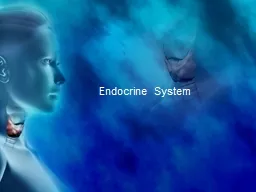

Endocrine System Regulates overall metabolism homeostasis growth and reproduction Glands are ductless tubeless organs that specialize in the secretion of substances needed by an organism ID: 397830
Download Presentation The PPT/PDF document "Endocrine System" is the property of its rightful owner. Permission is granted to download and print the materials on this web site for personal, non-commercial use only, and to display it on your personal computer provided you do not modify the materials and that you retain all copyright notices contained in the materials. By downloading content from our website, you accept the terms of this agreement.
Slide1
Endocrine SystemSlide2Slide3
Endocrine System
Regulates overall metabolism, homeostasis, growth and reproduction
Glands
– are ductless (tubeless) organs that specialize in the secretion of substances needed by an organism
directly
into the bloodstream.
Hormones
– chemical substances that are produced in glands and help regulate your body’s functions. The secretions produced by the endocrine glands
- released into the bloodstreamSlide4
Endocrine Glands
Hypothalamus
– part of the CNS, but it produces hormones that influence the pituitary gland
Pituitary Gland
– the “master gland” – regulates and controls the activities of all of the other endocrine glands.
Located at the base of the brain
Secretes
growth hormone
which affects growth of bone and cartilageSlide5
Why is the Hypothalamus so Important?
Secretes regulatory homones
RH
RIH
"Directs" pituitarySlide6
Pituitary
Pituitary
The pituitary gland produces a
growth hormone
which controls growth and homeostasis.Slide7Slide8
Endocrine Glands (continued)
Thyroid Gland
Located in the neck
Secretes
thyroxine
which regulates the rate of metabolism in the body
Parathyroid Gland
Embedded in the back of the thyroid
Secretes parathormone which controls metabolism of calcium and phosphateSlide9
Thyroid
Thyroid
The thyroid gland produces
thyroxin
to regulate metabolism.Slide10Slide11Slide12
Parathyroid
Parathyroid
The parathyroid gland produces
parathormone
which controls calcium levels in the body.Slide13
Endocrine Glands (continued)
Adrenal Glands
Located on top of the kidneys
Secrete
adrenaline
which helps deal with stress and accelerates the heart and breathing rates
Fight or Flight
Islets of Langerhans
– specialized cells
Located in the pancreas
Secrete
insulin
and
glucagon
Insulin
lowers blood sugar
Glucagon
raises blood sugarSlide14
Adrenal Insufficiency
Addison’s disease--
hyposecretion
of cortisol
JFK
Darkened skin (ACTH mimics MSH)
Weight loss, hypoglycemia
Find the anomaly in the feedback loop.
Inability to handle stressSlide15
Adrenals
Adrenals
Adrenals
The adrenal glands produce
adrenaline
in response to physical and emotional stress.Slide16
Adrenal glandSlide17
Adrenal ProblemsSlide18
Liver and PancreasSlide19
Pancreas
Pancreas
The pancreas produces
insulin
which controls sugar levels in the blood.Slide20
Endocrine Glands (continued)
Gonads
– sex glands
Male gonads are called testes
Located in the scrotum
Secrete
testosterone
which regulates male secondary sex characteristics
Female gonads are called ovariesLocated in the pelvic region
Secrete
estrogen
and
progesterone
which regulate female secondary sex characteristicsSlide21
Testes (in males)
Testes
The testes produce
testosterone
used in sperm production and the development of male traits.Slide22
Ovaries (in Females)
Ovaries
The ovaries produce
estrogen
used in egg production and the development of female traits.Slide23
Feedback Mechanisms
Negative Feedback
– is when an activity alters a condition in the body, and this triggers a series of events that reverses the altered condition
Ex. Body temperature
When body temp. goes up, we sweat
When body temp. goes down, we shiver
Ex. Blood sugar levels
When blood sugar goes up, insulin lowers blood sugar
When blood sugar goes down, glucagon raises blood sugarSlide24
A. Positive Feedback
Not common
Classic example:
Action of OXYTOCIN on uterine muscle during birth.Slide25
Disorders
Diabetes
– is a disease where a person cannot produce insulin
Inability of the body to store sugar as glycogen
Goiter
– is enlargement of the thyroid gland caused by iodine deficiencySlide26
DIABETESSlide27
DIABETESSlide28Slide29Slide30
GoiterSlide31Slide32
Other Disorders
Grave’s Disease
: hyperthyroidism, an autoimmune disorder in which an overactive and enlarged thyroid gland produces excessive amounts of
thyroxine
.
Cushing’s Disease:
overproduction of adrenal hormones.
Growth Disorders:
abnormal amounts of growth hormone. Slide33
GH as
Juvenile (Gigantism)Slide34
GH = pituitary dwarfismSlide35
GH as an Adult